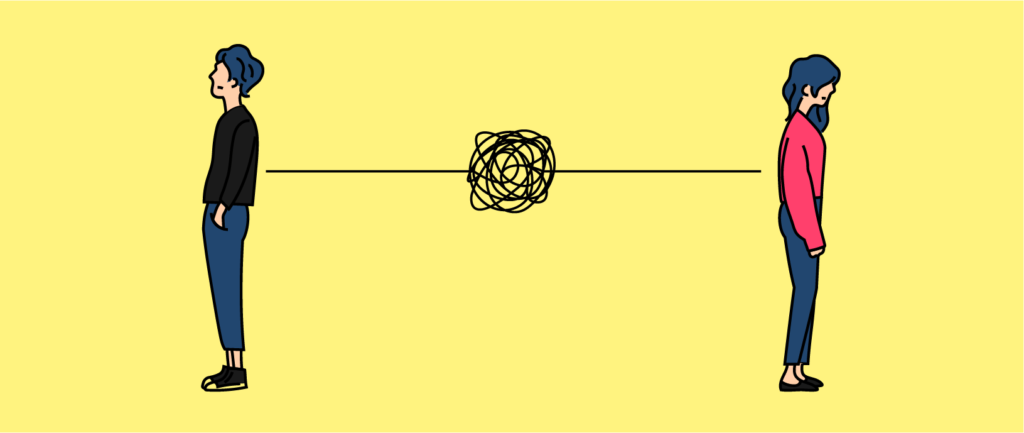
by Kate McLaughlin
CAT – How can we find greater agency in adaptive relational dynamics?
One of the therapeutic models that we regularly provide is Cognitive Analytic Therapy, often referred to as CAT or sometimes Relational Therapy. This is because the main goal of CAT, compared to other commonly used forms of therapy, is to recognise where there are repeating patterns in our relational dynamics. If these patterns are unwanted, and causing problems that we would prefer to change, these cycles can be broken by replacing them with an approach to relationships that is reciprocal, constructive and communicative.
Why is CAT used?
As you might expect, CAT is typically used to explore the difficulty that a client is having in forming and maintaining romantic relationships. However, the main issue that this process is designed to address is that the client doesn’t have the necessary relational skills that are applicable for the relationships that they’re struggling with. This could be due to a lack of experience in reciprocal relationships, but most often it is that there’s already a well-established set of beliefs, expectations and behaviours that isn’t an appropriate match for the relationships that the client is bringing it to.
These internalised preconceptions that we have about ourselves and the other people in our lives is sometimes referred to as our internal working model for relationships. This isn’t something that we’re likely to notice or think about very often in day to day life, unless we’re actively, regularly trying to ask ourselves what we believe and why we act in the ways that we do. It is also not something that we’re likely to find very helpful or to keep doing for very long unless without being supported in the process.
CAT is an opportunity for a client to receive that support from the therapist over a structured course of guided exploration and growth. This begins with a discussion about the problems that are currently happening and how they’ve happened in the past, so that the client and therapist can both recognise how and why these patterns first formed and what’s preventing them from going away on their own.
The point of this is to help the client have a more intimate understanding of what their own internal working model for relationships is, and which parts of it is responsible for the cycles of behaviour that they want to change. This process may take as little as 6-8 sessions under the right circumstances, and is one of the main reasons why CAT was developed as a direct and accessible way to facilitate this process for patients of the NHS.
What obstacles come with CAT?
It is not uncommon for there to be obstacles in the process of CAT. Examining the history of our relational issues in this much detail is a very vulnerable thing to do, and can often be more painful, confusing or difficult than expected. This only becomes more true, the less of an understanding we have to begin with of the ways that we act and feel towards others. It is understood that the course of therapy might need to be extended to account for the extra support that’s needed, either by proceeding at a slower pace or pausing the examination to resolve these issues first.
Once the client and the therapist have fully explored these blind spots, they then revise what they have discovered together to identify what needs to change to prevent the unwanted patterns from reoccurring.
In a shorter course of CAT, this would be everything that the client believes they need in order to make these changes. However, CAT can also be extended from this point to support the client through a more challenging long-term process of making these adjustments to their internal working model.
This will often involve finding new beliefs that will be more appropriate to the client’s relationships than the ones that they want to replace. These beliefs can then be practised and eventually internalised as part of an internal working model that isn’t going to cause the same sorts of unwanted conflicts, going forwards. Typically, if a course of CAT is extended for either of these reasons, it may instead last for as many as 24 sessions.
It is important to note that CAT works in the same way when supporting other types of interpersonal issues as well, and isn’t just applied to romantic partnerships. Wherever there’s a problem that keeps happening in a client’s friendships, family life, workplace dynamics or any other kind of relationship that two or more people might share, the answer lies in addressing the beliefs and feelings that are causing these problems.
It is for this reason that CAT is sometimes used as an alternative to, or supplement for, professional mediation. This might be the case if it is discovered that there are issues in the relational dynamics between the clients that are getting in the way of a constructive discussion. It is often found that by taking the time to recognise the nature of these obstacles, they can then be addressed first before continuing the process unobstructed.
The perspective works with the same understanding that there are unmet access needs which are preventing the client from being able to engage with the process, as opposed to a lack of interest.

There are limits to the potential benefits of CAT in and of itself for other issues that a client may require support with, such as psychosis or chronic trauma recovery. As a form of talking therapy, it may also be inappropriate if the client is nonverbal, or has similar access needs that can’t be accommodated within the scope of the model. Additionally, like many other revision or reframing-based cognitive models, CAT relies upon the assumption that the client’s relational dynamics continue to be entirely maladaptive for current life. If the client is going to remain feeling unsafe without these protective patterns of thinking and behaviour, then they’re likely to return as a necessary part of their internal working mode after being removed or replaced.
Despite this, CAT has remained popular as a model since first being introduced because of its clear and direct focus on relational issues, while also being a collaborative process between client and clinician. In particular, it is often recommended for supporting clients with personality disorders. This is one of the many instances which are benefited by CAT’s approach of clinical acceptance and absence of judgement.
If you would like to learn more about CAT and the other therapeutic models that we are able to deliver, or how we can help support any of the issues mentioned in this article, please contact us on 01282 685345 or at office@jsapsychotherapy.com


